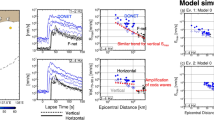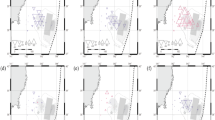Abstract
Long-term passive source ocean bottom seismograph (OBS) observatory is challenging due to various technical difficulties. In order to gain experience in this field, and to reveal the lithospheric structure beneath the extinct ridge in the central South China Sea (SCS), we carried out a passive source OBS array experiment, which includes 18 OBSs, in the deep portion of SCS. Here we present the instrumentation, the OBS deployment and recovery of this experiment, and more importantly, the data quality evaluated by a number of approaches. Through processing and inspecting waveforms from global, regional and local earthquakes, we find that most of recovered OBSs have good data quality with discernible main phases. The ambient noise analyses of OBS recordings show that their noise is higher than the global average, and the horizontal component is noisier than the vertical, indicating current impacts on horizontal components are more severe. In the period range of 5–10 s, there is a noise notch for the SCS OBSs, and noise levels of horizontal components are comparable to the vertical. This feature, which is not seen at OBS stations in open ocean, suggests the distant sources for double frequency microseism in this marginal sea are not significant. In addition, we successfully determined the orientations for 7 OBSs by investigating their Rayleigh wave polarizations; and we demonstrated the dispersion feature of Rayleigh waves through the frequency-time analysis. Finally, we summarized lessons learned from this experiment regarding the passive source OBS investigations in SCS.









Similar content being viewed by others
References
Favali P, Beranzoli L (2006) Seafloor observatory science: a review. Annals Geophys 49:515–567
Suyehiro K, Montagner JP, Stephen RA et al (2006) Ocean seismic observatories. Oceanography 19:144–149
Stephen RA, Spiess FN, Collins JA et al (2003) Ocean seismic network pilot experiment. Geochem Geophys Geosys 4:1092. doi:10.1029/2002GC000485
Romanowicz B, McGill P, Neuhauser D et al (2009) Acquiring real time data from the broadband ocean bottom seismic observatory at Monterey Bay (MOBB). Seismol Res Lett 80:197–202
Lay T (ed) (2009) Seismological grand challenges in understanding earth’s dynamic systems. Report to the National Science Foundation, IRIS Consortium, p 76
Ruan AG, Li JB, Lee CS et al (2012) Passive seismic experiment and ScS wave splitting in the southwestern sub-basin of South China Sea. Chin Sci Bull 57:3381–3390
Ruan AG, Li JB, Chen YS et al (2010) The experiment of broadband I-4C type OBS in the Southwest India ridge. Chin J Geophys 53:1015–1018 (in Chinese)
Qiu XL, Zhao MH, Ao W et al (2011) OBS survey and crustal of the southwest sub-basin and Nansha block, South China Sea. Chin J Geophys 54:3117–3128 (in Chinese)
Liu LH, Lu CC, Hao TY et al (2012) Data processing methods of OBS and its development tendency in detection of offshore oil and gas resources. Prog Geophys 27:2673–2684 (in Chinese)
Kudrass HR, Wiedicke M, Cepek P et al (1986) Mesozoic and Cenozoic rocks dredged from the South China Sea (Reed Bank area) and Sulu Sea and their significance for plate-tectonic reconstructions. Mar Petrol Geol 3:19–30
Wang XJ, Wu M, Liang D et al (1984) Some geochemical characteristics of basalts in the South China Sea. Geochimica 4:332–340 (in Chinese)
Yan QS, Shi XF, Wang KS et al (2008) Major trace elements and Sr-Nd-Pb isotope study of Cenozoic alkali basalts of the South China Sea. Sci China Ser D Earth Sci 51:550–566 (in Chinese)
Yang SY, Fang NQ, Yang SX et al (2011) A further discussion on formation background and Tectonic constraints of Igneous Rocks in Central sub-basin of the South China Sea. Earth Sci J Chin Univ Geosci 36:454–470 (in Chinese)
Xu YG, Wei JX, Qiu HN et al (2012) Opening and evolution of the South China Sea constrained by studies on volcanic rocks: Preliminary results and a research design. Chin Sci Bull 57:3150–3164
Clague DA, Paduan JB, Duncan RA et al (2009) Five million years of episodic alkalic volcanism built Davidson Seamount atop an abandoned spreading center. Geochem Geophys Geosys 10:Q12009. doi:10.1029/2009/GC002665
Castillo PR, Clague DA, Davis AS et al (2010) Petrogenesis of Davidson Seamount lavas and its implications for fossil spreading center and intraplate magmatism in the eastern Pacific. Geochem Geophys Geosys 11:Q02005. doi:10.1029/2009GC002992
Haase KM, Beier C, Fretzdorff S et al (2011) Magmatic evolution of a dying spreading axis: evidence for the interaction of tectonics and mantle heterogeneity from the fossil Phoenix Ridge, Drake Passage. Chem Geol 280:115–125
Haase KM, Regelous M, Duncan RA et al (2011) Insights into mantle composition and mantle melting beneath mid-ocean ridges from postspreading volcanism on the fossil Galapagos Rise. Geochem Geophys Geosys 12:Q0AC11. doi:10.1029/2010GC003482
Huang ZX, Xu Y (2011) S-wave velocity structure of South China Sea and surrounding regions from surface wave tomopraphy. Chin J Geophys 54:3089–3097 (in Chinese)
Tang Q, Zheng C (2013) Crust and Upper Mantle Structure and its tectonic implications in the South China Sea and Adjacent Regions. J Asian Earth Sci 62:510–525
Guralp Systems (2008) Portable sub-Sea broadband seismic instrumentation,specification for a portable sub-sea science instrumentation package including broadband seismometer. Technique Proposal Part No TEC-PRO-OBS_40T
You QY, Liu FT, Rang CR et al (2003) High frequency micropower ocean bottom seismograph. Prog Geophys 18:173–176 (in Chinese)
Pozgay SH, Wiens DA, Conder JA et al (2007) Complex mantle flow in the Mariana subduction system: evidence from shear wave splitting. Geophys J Int 170:371–386
Weeraratne DS, Forsyth DW, Yang Y et al (2007) Rayleigh wave tomography beneath intraplate volcanic ridges in the South Pacific. J Geophys Res 112:B06303. doi:10.1029/2006JB004403
Gaherty J, Lin PY (2013) Lithosheric structure of the central Pacific: early returns from the NoMelt Experiment, Paper presented at OBSIP 2013 workshop, Redondo Beach, CA, USA, 20–22
Collins J, Vernon F, Orcutt J et al (2001) Broadband seismology in the oceans: lessons from the Ocean Seismic Network Pilot Experiment. J Geophys Res 28:49–52
Crawford W, Webb S (2000) Identifying and removing tilt noise from low-frequency (<0.1 Hz) seafloor vertical seismic data. Bull Seismol Soc Am 90:952–963
Dahm T, Tilmann F, Morgan JP (2006) Seismic broadband ocean-bottom data and noise observed with free-fall stations: experiences from long-term deployments in the North Atlantic and the Tyrrhenian Sea. Bull Seismol Soc Am 96:647–664
Yang T, Shen Y (2006) Frequency-dependent crustal correction for finite-frequency seismic tomography. Bull Seismol Soc Am 96:2441–2448
Webb SC (1998) Broadband seismology and noise under the ocean. Rev Geophys 36:105–142
Huo D, Yang T (2013) Seismic ambient noise around the South China Sea: seasonal and spatial variations, and implications for its climate and surface circulation. Mar Geophys Res 34:449–459
McNamara D, Buland RP (2004) Ambient noise levels in the continental United States. Bull Seismol Soc Am 94:1517–1527
Peterson J (1993) Observation and modeling of seismic background noise. US Geological Survey Open File Report, Albuquerque, pp 93–322
Stutzmann E, Roult G, Astiz L (2000) Geoscope station noise level. Bull Seismol Soc Am 90:690–701
Bromirski PD (2009) Earth vibrations. Science 324:1026
Bromirski PD, Duennebier FK, Stephen RA (2005) Mid-ocean microseisms. Geochem Geophys Geosys 6:Q04009. doi:10.1029/2004GC000768
Anderson P, Duennebier F, Cessaro R (1987) Ocean borehole horizontal seismic sensor orientation determined from explosive charges. J Geophys Res 92:3573–3579
Duennebier F, Anderson P, Fryer G (1987) Azimuth determination of and from horizontal ocean bottom seismic sensors. J Geophys Res 92:3567–3572
Stachnik JC, Sheehan AF, Zietlow DW et al (2012) Determination of New Zealand ocean bottom seismometer orientation via Rayleigh-wave polarization. Seismol Res Lett 83:704–713
Forsyth DW, Webb SC, Dorman LM et al (1998) Phase velocities of Rayleigh waves in the MELT experiment on the East Pacific Rise. Science 280:1235–1238
Harmon N, Forsyth DW, Weeraratne DS et al (2009) Thickening of young pacific lithosphere from high-resolution Rayleigh wave tomography: a test of the conductive cooling model. Earth Planet Sci Lett 278:96–106
Levshin AL, Yanocskaya TB, Lander AV et al (1989) Seismic surface waves in a laterally inhomogeneous Earth. In: Keilis-borok VI (ed) Modern approach in geophysics, vol 9. Kluwer Academic Publishers, Dordrecht, pp 153–163
Acknowledgments
We thank the First Institute of Oceanography, State Oceanic Administration and Institute of Geology and Geophysics, Chinese Academy of Sciences for providing us the instruments; all crews at R/V Dong Fang Hong 2 and R/V Tian Long for their indispensable work at sea, and two reviewers for their constructive reviews. This work was supported by National Natural Science Foundation of China (91128209 and 40176019) and State Key Laboratory of Marine Geology at Tongji University (MG20130306).
Author information
Authors and Affiliations
Corresponding author
About this article
Cite this article
Liu, C., Hua, Q., Pei, Y. et al. Passive-source ocean bottom seismograph (OBS) array experiment in South China Sea and data quality analyses. Chin. Sci. Bull. 59, 4524–4535 (2014). https://doi.org/10.1007/s11434-014-0369-4
Received:
Accepted:
Published:
Issue Date:
DOI: https://doi.org/10.1007/s11434-014-0369-4




